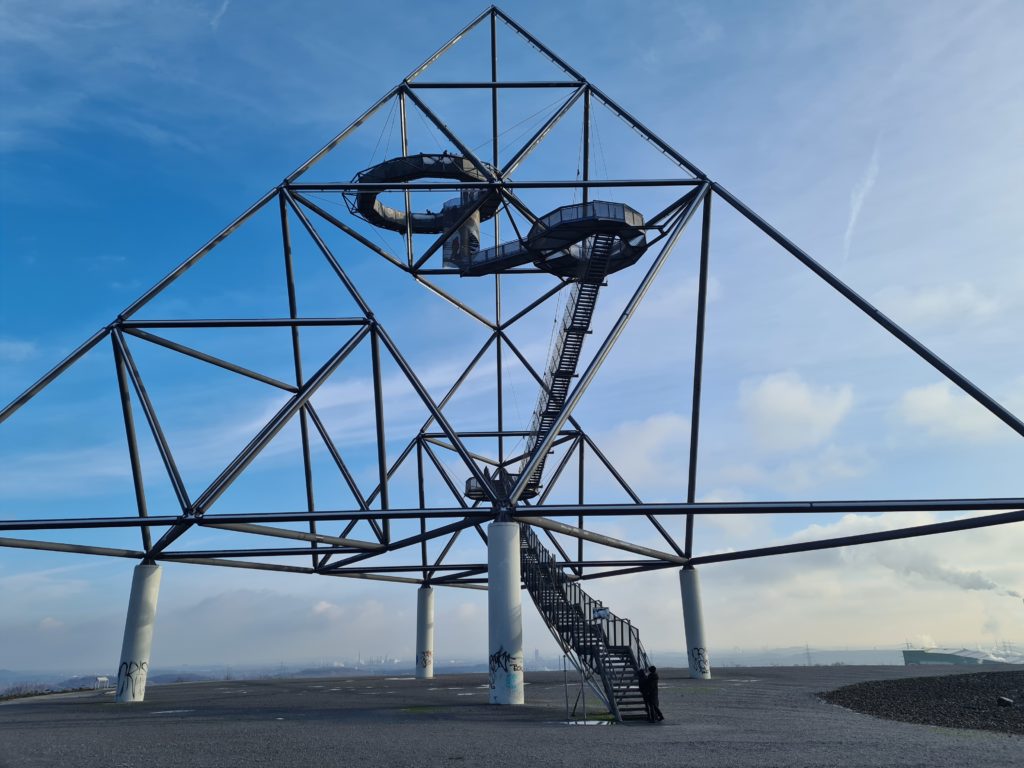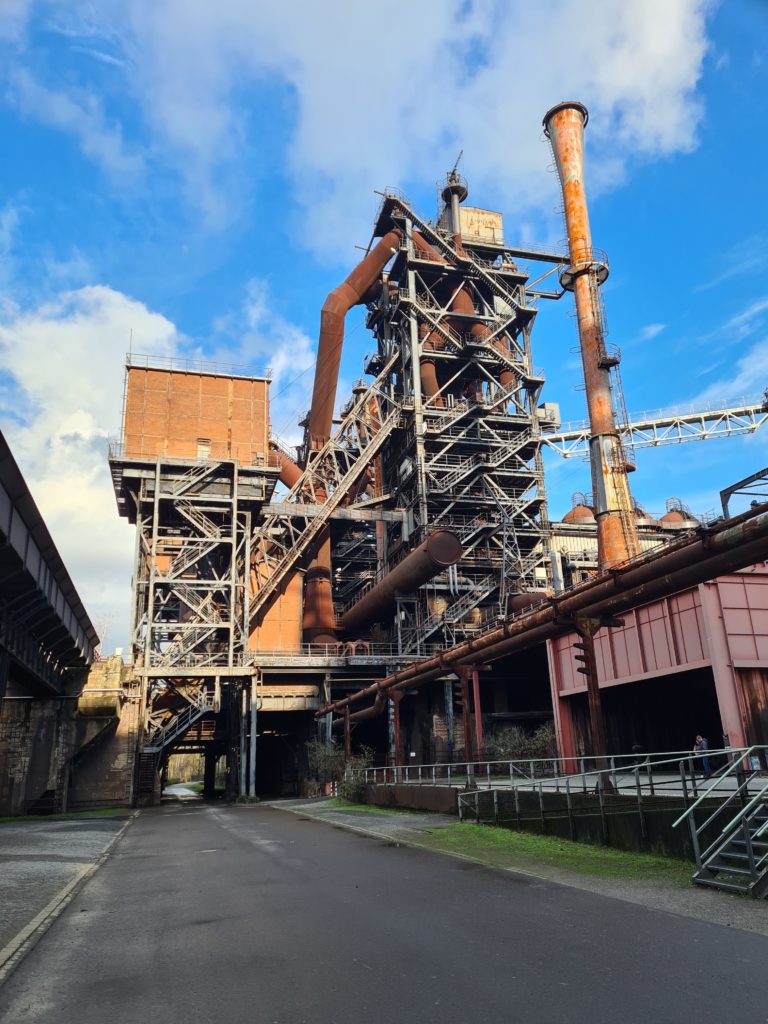
We, the geography classes of Mr. Simon, Mrs. Burkhardt and Mrs. Neuen met at 7.30 am on January 17th at the MEG parking lot to get on the bus taking us to different sights of the Ruhr Area relating to the topic of structural change.
After a quickly passing hour on the bus we arrived in Essen where we took a short break and picked up our two tour guides. Then we continued our trip to our first actual stop the “Zeche Zollverein.” in Essen. Upon arrival we split into two groups . Then we walked the area of the Zeche Zollverein while being informed about the impressive history and functions of this former coal mine as well as the thought-out architecture and the current usage of the building. Especially notable is how the Zeche defined not only its own but the architecture and development of the entire city of Essen.
We then headed back to the bus and after a short bus ride arrived at Bottrop at the foot of a heap with the famous Tetraeder on top. After we had made it up to the top of the heap we found ourselves 65m higher and right in front of the approximately 50m high Tetraeder. Our guide told us about the reasons for building a construction like this and how the Tetraeder`s shape is linked to the chemical element methane, which was of special importance in the surrounding coal mines. He then also explained how we were basically standing in the centre of the Ruhr Valley and right next to one of the three remaining active coking plants. Now that we knew why this Tetraeder was built here, it was time for us to hike up to its peak. It definitely was an experience worth making, as the view over all the different coal mines and mine dumps really painted a picture of what this area once must have looked like and the tremendous effect of structural change.
We now walked down the 65m high hill to the bus and after another 90 minute drive arrived at the Centro Oberhausen. Everybody was glad that we were able to get some food and relax for some time and so we enjoyed the culinary diversity the Centro, yet another monument of tertiarization, had to offer. Satisfied and relaxed we then took the bus one more time to get to our last landmark of structural change, the Landscape park Duisburg-Nord.
Here we were able to get even more information about the coking plants and got special insight into the work and lives of former employees. Today the landscape park is a huge public area, where one can enjoy various free time activities like climbing. diving, cycling or joining public events. What especially stuck in mind was the view from the top of a blast furnace and the many ways in which nature had reclaimed the land that was left alone for 30 years.
At 3pm we then went back to the bus and drove back to school, where we arrived right when the bell rang to end school for the day.
(Text & pictures: EKE Q1)
Exkursion der Q1 ins Ruhrgebiet
An diesem Morgen trafen wir uns mit allen Erdkunde-Kursen der Q1 des Michael-Ende-Gymnasiums, um auf eine Exkursion ins Ruhrgebiet zu fahren. Um 7:30 trafen wir uns auf dem Parkplatz der Schule und gegen kurz vor 8 fuhren wir dann mit unserem Reisebus ins Ruhrgebiet. Unser erster Halt war Essen, dort haben wir zuerst unsere beiden Reiseführer abgeholt. Nach einer kurzen Pause vor dem Regionalverband Ruhr ging die Fahrt dann weiter zur “Zeche-Zoll-Verein“. Vor Ort und auf dem Weg dorthin haben wir eine Menge über die Vergangenheit des Ruhrgebiets und dem Aufbau der Stadt und der Zeche-Zoll-Verein gelernt. Diese Zeche war Anfang des 20. Jhdt. die größte, modernste und schönste Zeche Europas. Weiter ging die Fahrt dann nach Bottrop auf den berühmten Tetraeder, welcher auf einer der Halden gebaut wurde. Diese Halden, welche im Ruhrgebiet oft vorkommen, wurden damals aus dem Gestein, welches bei der Trennung der Steinkohle übrigblieb, aufgebaut. Nachdem wir die Möglichkeit hatten, auf das Tetraeder, welches ca. 38 Meter hoch ist, zu steigen, sind wir danach in die Nachbarstadt Oberhausen, für eine kleine Pause von etwa einer Stunde gefahren. Vor Ort konnten wir uns im Oberhausen Centro aufhalten, bevor es dann weiter nach Duisburg, zum Landschaftspark Duisburg Nord ging. Dort haben wir uns hauptsächlich die Stahlöfen angeschaut, welche 1985 zuletzt saniert wurden. Viele Teile des Landschaftsparkes wurden für Freizeitaktivitäten umgebaut, dort kann man heutzutage zum Beispiel bei der Gießen Halle ein Open-Air Kino sich anschauen, in einer der Hochöfen wurde ein Kletterpark errichtet oder man kann in dem etwas kleineren Gasometer, welcher immer noch eine tiefe von 13 Metern hat, tauchen gehen. Außerdem finden dort auch viele Events, Veranstaltungen oder ähnliches statt. Duisburg war auch schon der letzte Punkt unserer Liste. So ging es also wieder zurück zur Schule. Unsere Reiseführer haben wir auf dem Rückweg am Duisburg Hbf. rausgelassen und waren dann gegen 16 Uhr wieder zurück an der Schule. Insgesamt war dies ein sehr interessanter und lehrreicher Tag.




